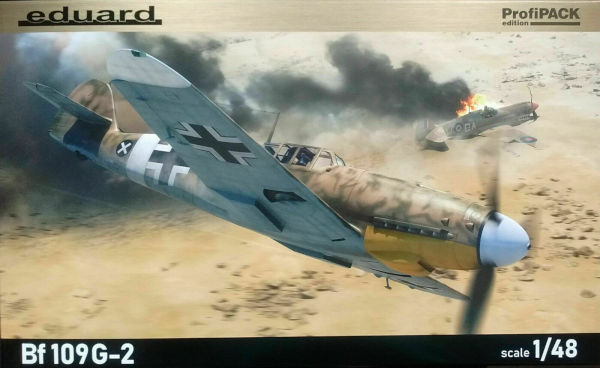
Eduard 1/48 Messerschmitt Bf109G-2 ProfiPACK
By Jacob Russell
The Plane
The Messerschmitt Bf109G-2 was a non-pressurized fighter which reached operational status several weeks before the pressurized Bf109G-1. The G-2 was powered by the 1,475 hp Daimler-Benz DB-601a inverted vee-12 cylinder engine and was armed with the engine mounted 20MM MG 151/20 cannon and a pair of cowling mounted MG 17 machine guns.
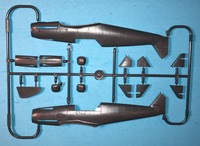
|
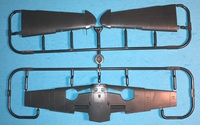
|
Many pilots felt that the G-2 was underarmed so Messerschmitt mounted an MG 151 cannon under each wing. The resulting modification was called the R-6 or “Kannonenboot” (Cannon boat) option. The G-2 rapidly replaced the Friedrich in service. JG 2 Richtofen received their first Gustavs in late April 1942.
Eduard's new ProfiPACK G-2 kit comes in a stout box with cool artwork of a Bf109G-2 fighter buzzing the P-40 it just has downed, somewhere in North Africa. It consists of 184 plastic parts on 5 sprues, one of which is clear.
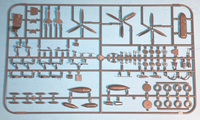
|
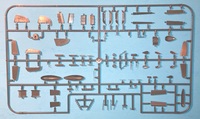
|
The Kit
The kit consists of 246 parts. 195 of the parts are injection molded plastic on 5 sprues. There are also 50 parts on a single photo-etch fret. Some of these parts are pre-painted and you also get a rice paper mask set.
The surface detail on the wings and fuselage consists of recessed panel lines and rivets and this detail is superb. The wheel wells are deep, multi-piece moldings that are convincing in their complexity. The wing leading edge slats are separate pieces.
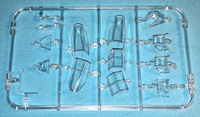
|
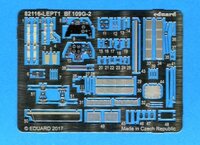
|
The ailerons, underwing radiator flaps and horizontal stabilizers are individual pieces. The fabric effect on the ailerons, rudder and horizontal stabilizers is good. The landing gear is well executed.
The clear parts include 2 gunsights, 3 different windscreens, the fuel return line, the "Galland Panzer" canopy armor and 3 different Erla Haube canopies, which are destined for the spare parts bin as they're not applicable to the G-2 variant.
Optional parts include a number of Rustsatze (field conversion sets): R-1 (ETC 900/IXb rack with SC 250 bomb), R-2 (ETC 50/VIId rack with 4 SC 50 bombs), R-3 (300 liter drop tank), R-6 (MG 151/20MM under wing cannon) and R-7 (Direction Finding (DF) loop).
The PE fret includes an instrument panel, seat harness, rudder pedals, oil cooler and wing radiator faces, etc. Other upgrades include exhaust shields, the landing gear retraction chain and the port cockpit light.
Eduard's decals are crisply printed, with bright colors and good registration. There are 2 sheets, one of which provides 2 sets of air frame stencils. The main decal sheet includes 5 different aircraft options, 4 of which sport the under wing "Gondola" cannon:
"White 3", G-2/trop, W.Nr. 10533, Uffz. Horst Schlick, 1./JG 77, Bir-el-Abd, Egypt, November 1942. This G-2 was painted in the standard Desert camouflage scheme of RLM 79 over RLM 78 with irregularly spray-painted patches of RLM 80 Dark Green with a white spinner, wing tips and fuselage band. The spinner had an RLM 70 Dark Green backing plate and the lower cowl was RLM 04 Yellow
"Yellow 10", G-2/R-6/trop, W.Nr. 13916, Fw. Hans Döbrich, 6../JG 5, Alakurtti, Finland, February 1943. This Kannonenboote had RLM 74/75/76 camouflage with white temporary distemper paint sprayed over all of the upper surfaces. The wingtips and lower cowl were RLM 04 Yellow and the spinner and backing plate were 50/50 white and RLM 70 Dark Green. The windscreen and canopy were left in their camouflage colors.
"Yellow 5", G-2, Lt. Walter Kropinski, 6../JG 52, Maykop, Finland, February 1943. This G-2 had RLM 74/75/76 camouflage with RLM 04 Yellow, wingtips, lower cowl and fuselage band. The spinner and backing plate were 50/50 white and RLM 70 Dark Green. The aircraft's previous markings were over painted with large areas of RLM 75 and the fuselage had extensive RLM 74/75 mottling.
"Double Black Chevron", G-2/R-6/trop, W.Nr. 13949, Maj. Hans Hahn, 6./JG 5, Alakurtti, Finland, February 1943. Another Kannonenboote with mid-War RLM 74/75/76 camouflage and white temporary distemper paint sprayed over all of the upper surfaces. The lower wingtips, fuselage band and lower cowl were RLM 04 Yellow. The spinner and backing plate were 50/50 white and RLM 70 with a light application of white distemper paint.
"White 1", G-2/R-6, W.Nr. 13633, Hptm. Wolf Dieter-Huy, 7./JG 77, Tanyet Harun, Egypt, October 1942. This VERY distinctive Kannonenboote was painted with large areas of RLM 70/71 over RLM 76. The wingtips, spinner and fuselage band were white. The spinner and backing plate were 50/50 white and the lower cowl was RLM 04 Yellow.
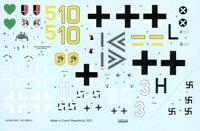
|
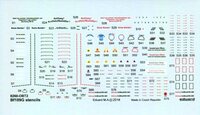
|
The instructions are up to Eduard's usual standards. The instructions include a parts map, a well illustrated and logical build sequence, full color profiles of all 4 decal options and a stencil application guide. Color callouts are for GSI Creos (Gunze) Aqueous, Mr. Color and Mission Models paints.
Conclusion
Eduard's Messerschmitt Bf109G-2 is a great kit. It's accurate and well detailed right out of the box and if you are so inclined you can choose from Eduard's numerous photo-etched and Brassin enhancements to add even more detail. I recommend this kit, and I would like to thank Eduard for providing the review sample.
References
Messerschmitt Bf109 in action Part 2, Aircraft Number 57, by John R. Beaman, Jr., Squadron/Signal Publications, 1983
